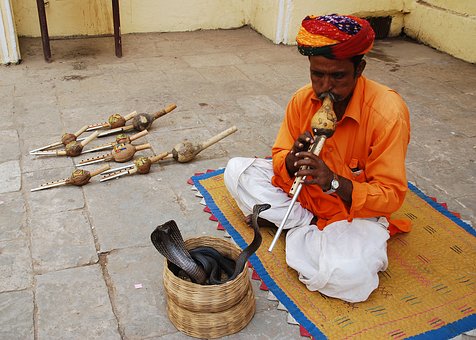Archived Blogs
|
My husband says that there are only two types of snakes. Those that slither away from him and choose life… and those that dare to approach and choose death. According to a snake removal service, it can be difficult to tell a venomous snake from a non-venomous snake. The characteristics that I’ve heard before: triangular head, distinct pattern, and even the rattle, can be confusing. (up to 99% of snakes have triangular heads) Elliptical eyes can be a sign of a poisonous snake but who wants to get that close? Maybe my husband’s approach is the best after all... I don’t find snakes very appealing but I’ve met people that do. I was at a fair recently and found several men who draped their pets around their necks like fashion accessories. Snake charming is the practice of appearing to hypnotize a snake. It likely started in India but it’s a dying custom. (animal rights activists) Years ago I saw a charmer while visiting Jaipur. An old man sat cross-legged in front of his basket playing music from a flute-like instrument. The snake didn’t respond until he thumped the container with his foot. Snakes don’t hear so when they rise up, they are not hypnotized but adopting a defensive posture to what they perceive as a threat. In the past, snake charmers would remove the dangerous reptiles from private homes and were known as healers for snake bites. It was only later that they became known as a tourist attraction. Did you know that snake charming is even in the Bible? Psalm 58:3–5: "The wicked turn aside from birth; liars go astray as soon as they are born. Their venom is like that of a snake, like a deaf serpent that does not hear, that does not respond to the magicians, or to a skilled snake-charmer.” It turns out the job is not always as dangerous as it looks. Charmers often remove the poisonous glands and fangs from the snakes they work with. Some will actually stitch the mouth closed, allowing only room for the tongue to wiggle out. Those snakes are doomed to die of starvation.
There are all types of ideas of how to treat snake bites. Here’s a story of a policeman in India who relied on a “snake stone”. Other traditional measures have included incising the site, sucking out the venom, applying a tourniquet, and applying ice. One therapy that I’d never heard of was using electricity. I’m a little vague on that one but I wouldn’t like to experiment with it. Just FYI. The correct treatment of a snake bite:
0 Comments
Leave a Reply. |
Archives
October 2020
Categories |
COPYRIGHT 2017 SUSAN BADARACCO | Site Credits




 RSS Feed
RSS Feed